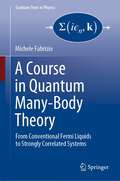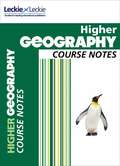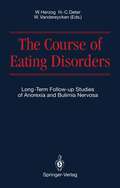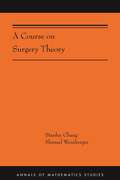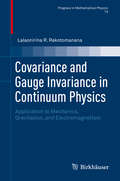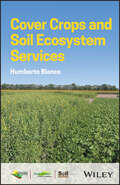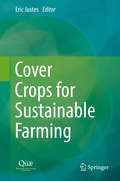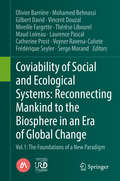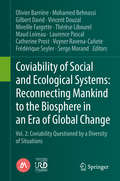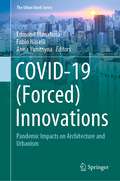- Table View
- List View
A Course in Mathematical Methods for Physicists
by Russell L. HermanBased on the author's junior-level undergraduate course, this introductory textbook is designed for a course in mathematical physics. Focusing on the physics of oscillations and waves, A Course in Mathematical Methods for Physicists helps students understand the mathematical techniques needed for their future studies in physics. It takes a bottom-u
A Course in Mathematical Methods for Physicists
by Russell L. HermanBased on the author's junior-level undergraduate course, this introductory textbook is designed for a course in mathematical physics. Focusing on the physics of oscillations and waves, A Course in Mathematical Methods for Physicists helps students understand the mathematical techniques needed for their future studies in physics. It takes a bottom-u
A Course in Mathematical Physics: Volume 4: Quantum Mechanics of Large Systems
by Walter ThirringIn this final volume I have tried to present the subject of statistical mechanics in accordance with the basic principles of the series. The effort again entailed following Gustav Mahler's maxim, "Tradition = Schlamperei" (i.e., filth) and clearing away a large portion of this tradition-laden area. The result is a book with little in common with most other books on the subject. The ordinary perturbation-theoretic calculations are not very useful in this field. Those methods have never led to propositions of much substance. Even when perturbation series, which for the most part never converge, can be given some asymptotic meaning, it cannot be determined how close the nth order approximation comes to the exact result. Since analytic solutions of nontrivial problems are beyond human capabilities, for better or worse we must settle for sharp bounds on the quantities of interest, and can at most strive to make the degree of accuracy satisfactory.
A Course in Mathematical Physics 1: Classical Dynamical Systems
by Walter ThirringThis textbook presents mathematical physics in its chronological order. It originated in a four-semester course I offered to both mathematicians and physicists, who were only required to have taken the conventional intro ductory courses. In order to be able to cover a suitable amount of advanced materil;ll for graduate students, it was necessary to make a careful selection of topics. I decided to cover only those subjects in which one can work from the basic laws to derive physically relevant results with full mathematical rigor. Models which are not based on realistic physical laws can at most serve as illustrations of mathematical theorems, and theories whose pre dictions are only related to the basic principles through some uncontrollable approximation have been omitted. The complete course comprises the following one-semester lecture series: I. Classical Dynamical Systems II. Classical Field Theory III. Quantum Mechanics of Atoms and Molecules IV. Quantum Mechanics of Large Systems Unfortunately, some important branches of physics, such as the rela tivistic quantum theory, have not yet matured from the stage of rules for calculations to mathematically well understood disciplines, and are there fore not taken up. The above selection does not imply any value judgment, but only attempts to be logically and didactically consistent. General mathematical knowledge is assumed, at the level of a beginning graduate student or advanced undergraduate majoring in physics or mathe matics.
A Course in Mathematical Physics 1 and 2: Classical Dynamical Systems and Classical Field Theory (Springer Study Edition)
by Walter ThirringThe last decade has seen a considerable renaissance in the realm of classical dynamical systems, and many things that may have appeared mathematically overly sophisticated at the time of the first appearance of this textbook have since become the everyday tools of working physicists. This new edition is intended to take this development into account. I have also tried to make the book more readable and to eradicate errors. Since the first edition already contained plenty of material for a one semester course, new material was added only when some of the original could be dropped or simplified. Even so, it was necessary to expand the chap ter with the proof of the K-A-M Theorem to make allowances for the cur rent trend in physics. This involved not only the use of more refined mathe matical tools, but also a reevaluation of the word "fundamental. " What was earlier dismissed as a grubby calculation is now seen as the consequence of a deep principle. Even Kepler's laws, which determine the radii of the planetary orbits, and which used to be passed over in silence as mystical nonsense, seem to point the way to a truth unattainable by superficial observation: The ratios of the radii of Platonic solids to the radii of inscribed Platonic solids are irrational, but satisfy algebraic equations of lower order.
A Course in Mathematical Physics 2: Classical Field Theory
by Walter ThirringIn the past decade the language and methods ofmodern differential geometry have been increasingly used in theoretical physics. What seemed extravagant when this book first appeared 12 years ago, as lecture notes, is now a commonplace. This fact has strengthened my belief that today students of theoretical physics have to learn that language-and the sooner the better. Afterall, they willbe the professors ofthe twenty-first century and it would be absurd if they were to teach then the mathematics of the nineteenth century. Thus for this new edition I did not change the mathematical language. Apart from correcting some mistakes I have only added a section on gauge theories. In the last decade it has become evident that these theories describe fundamental interactions, and on the classical level their structure is suffi cientlyclear to qualify them for the minimum amount ofknowledge required by a theoretician. It is with much regret that I had to refrain from in corporating the interesting developments in Kaluza-Klein theories and in cosmology, but I felt bound to my promise not to burden the students with theoretical speculations for which there is no experimental evidence. I am indebted to many people for suggestions concerning this volume. In particular, P. Aichelburg, H. Rumpf and H. Urbantke have contributed generously to corrections and improvements. Finally, I would like to thank Dr. 1. Dahl-Jensen for redoing some of the figures on the computer.
A Course in Ordinary Differential Equations
by Stephen A. WirkusThe first contemporary textbook on ordinary differential equations (ODEs) to include instructions on MATLAB, Mathematica, and Maple�, A Course in Ordinary Differential Equations focuses on applications and methods of analytical and numerical solutions, emphasizing approaches used in the typical engineering, physics, or mathematics student's field o
A Course in Quantum Many-Body Theory: From Conventional Fermi Liquids to Strongly Correlated Systems (Graduate Texts in Physics)
by Michele FabrizioThis textbook presents various methods to deal with quantum many-body systems, mainly addressing interacting electrons. It focusses on basic tools to tackle quantum effects in macroscopic systems of interacting particles, and on fundamental concepts to interpret the behavior of such systems as revealed by experiments.The textbook starts from simple concepts like second quantization, which allows one to include the indistinguishability and statistics of particles in a rather simple framework, and linear response theory. Then, it gradually moves towards more technical and advanced subjects, including recent developments in the field. The diagrammatic technique is comprehensively discussed. Some of the advanced topics include Landau’s Fermi liquid theory, Luttinger liquids, the Kondo effect, and the Mott transition.The ultimate goal of the book is to gain comprehension of physical quantities that are routinely measured experimentally and fully characterize the system, therefore it is useful for graduate students but also young researchers studying and investigating the theoretical aspects of condensed matter physics.
Course Notes for SQA Exams — CFE HIGHER GEOGRAPHY COURSE NOTES (PDF)
by Sheena Williamson Fiona Williamson LeckieExam Board: SQA Level: Higher Subject: Geography First Teaching: 2014, First Exam: 2015 The CfE Higher Geography Course Notes helps teachers and students map their route through the CfE programme, providing comprehensive and authoritative guidance for the course. Progress and attainment for all • A complete core resource with all the Physical and Human Environments topics, and the three most popular Global Issues topics (River Basin Management, Development and Health and Global Climate Change) covered in depth • ‘Quick questions’ to check knowledge at the end of each chapter ensure that every student can progress securely • ‘Summary’ sections and ‘learning checklists’ help students to monitor progress regularly Active learning • ‘Make the link’ features encourage broader thinking between and across subjects • ‘Hints’ give helpful tips and highlight important information • ‘Activities’ provide opportunities to apply knowledge and put geographical skills to work Assessment and practice you can rely on • ‘Exam-style questions’ at the end of each chapter ensure that students will be fully prepared for the assessment • Dedicated chapter on the Application of Geographical Skills provides guidance and practice for this new part of the exam Course Notes give a practical, supportive approach to help deliver the new curriculum and offer a blend of sound teaching and learning with assessment guidance.
The Course of Eating Disorders: Long-Term Follow-up Studies of Anorexia and Bulimia Nervosa
by Dr Wolfgang Herzog Prof. Dr. Hans-Christian Deter Prof. Dr. Walter VandereyckenMore and more clinicians as well as researchers realize that anorexia nervosa and bulimia nervosa often are extremely difficult to treat and that the short-term outcome can be very misleading. In many cases these disordersprevail for a long period of time and can have serious consequences for the patient's further life. This book gives a detailed over- view oftoday's knowledge regarding the long-term outcome of the treatment of anorexic and bulimic patients, many of whom were treated in highly spezialized centers. Experts from bo- th Europe and the U.S. report on theirmost recent research. Their studies include medical as well as psychosocial and psychiatric aspects of eating disorders. Clinicians with long experience in the treatment of eating disorder patients discuss the important practical implications of these rese- arch findings. The information given in this book is helpful for both treatment and prevention of eating disorders. Finally, concrete guidelines show as how to conduct further follow-up studies in this field.
A Course on Hopf Algebras (Universitext)
by Rinat KashaevThis textbook provides a concise, visual introduction to Hopf algebras and their application to knot theory, most notably the construction of solutions of the Yang–Baxter equations. Starting with a reformulation of the definition of a group in terms of structural maps as motivation for the definition of a Hopf algebra, the book introduces the related algebraic notions: algebras, coalgebras, bialgebras, convolution algebras, modules, comodules. Next, Drinfel’d’s quantum double construction is achieved through the important notion of the restricted (or finite) dual of a Hopf algebra, which allows one to work purely algebraically, without completions. As a result, in applications to knot theory, to any Hopf algebra with invertible antipode one can associate a universal invariant of long knots. These constructions are elucidated in detailed analyses of a few examples of Hopf algebras. The presentation of the material is mostly based on multilinear algebra, with all definitions carefully formulated and proofs self-contained. The general theory is illustrated with concrete examples, and many technicalities are handled with the help of visual aids, namely string diagrams. As a result, most of this text is accessible with minimal prerequisites and can serve as the basis of introductory courses to beginning graduate students.
A Course on Nonlinear Waves (Nonlinear Topics in the Mathematical Sciences #3)
by S.S. ShenThe aim of this book is to give a self-contained introduction to the mathe matical analysis and physical explanations of some basic nonlinear wave phe nomena. This volume grew out of lecture notes for graduate courf;!es which I gave at the University of Alberta, the University of Saskatchewan, ·and Texas A&M University. As an introduction it is not intended to be exhaustive iQ its choice of material, but rather to convey to interested readers a basic; yet practical, methodology as well as some of the more important results obtained since the 1950's. Although the primary purpose of this volume is to serve as a textbook, it should be useful to anyone who wishes to understand or conduct research into nonlinear waves. Here, for the first time, materials on X-ray crystallography and the forced Korteweg-de Vries equation are incorporated naturally into a textbook on non linear waves. Another characteristic feature of the book is the inclusion of four symbolic calculation programs written in MATHEMATICA. They emphasize outcomes rather than numerical methods and provide certain symbolic and nu merical results related to solitons. Requiring only one or two commands to run, these programs have user-friendly interfaces. For example, to get the explicit expression of the 2-soliton of the Korteweg-de Vries equation, one only needs to type in soliton[2] when using the program solipac.m.
A Course on Surgery Theory: (AMS-211) (Annals of Mathematics Studies #390)
by Stanley Chang Shmuel WeinbergerAn advanced treatment of surgery theory for graduate students and researchersSurgery theory, a subfield of geometric topology, is the study of the classifications of manifolds. A Course on Surgery Theory offers a modern look at this important mathematical discipline and some of its applications. In this book, Stanley Chang and Shmuel Weinberger explain some of the triumphs of surgery theory during the past three decades, from both an algebraic and geometric point of view. They also provide an extensive treatment of basic ideas, main theorems, active applications, and recent literature. The authors methodically cover all aspects of surgery theory, connecting it to other relevant areas of mathematics, including geometry, homotopy theory, analysis, and algebra. Later chapters are self-contained, so readers can study them directly based on topic interest. Of significant use to high-dimensional topologists and researchers in noncommutative geometry and algebraic K-theory, A Course on Surgery Theory serves as an important resource for the mathematics community.
Courtship and Mating in Butterflies
by Raymond J CannonThis book presents a readable account of butterfly behaviour, based on field observations, great photographs and the latest research. The main focus is on courtship and mating - including perching, searching and territorial behaviour - but to understand these subjects it is necessary to explain how mates are chosen and this requires sections on wing colours and patterns. A chapter on butterfly vision is also essential in terms of how butterflies see the world and each other. There have been exciting discoveries in all of these fields in recent years, including: butterfly vision (butterfly photoreceptors), wing patterns (molecular biology), wing colouration (structural colours and nano-architecture), mating strategies and female choice (ecology and behaviour).
Covariance and Gauge Invariance in Continuum Physics: Application to Mechanics, Gravitation, and Electromagnetism (Progress in Mathematical Physics #73)
by Lalaonirina R. RakotomananaThis book presents a Lagrangian approach model to formulate various fields of continuum physics, ranging from gradient continuum elasticity to relativistic gravito-electromagnetism. It extends the classical theories based on Riemann geometry to Riemann-Cartan geometry, and then describes non-homogeneous continuum and spacetime with torsion in Einstein-Cartan relativistic gravitation. It investigates two aspects of invariance of the Lagrangian: covariance of formulation following the method of Lovelock and Rund, and gauge invariance where the active diffeomorphism invariance is considered by using local Poincaré gauge theory according to the Utiyama method. Further, it develops various extensions of strain gradient continuum elasticity, relativistic gravitation and electromagnetism when the torsion field of the Riemann-Cartan continuum is not equal to zero. Lastly, it derives heterogeneous wave propagation equations within twisted and curved manifolds and proposes a relation between electromagnetic potential and torsion tensor.
Covariant Techniques in Quantum Field Theory (SpringerBriefs in Physics)
by Enrique Álvarez Jesús AneroThe purpose of this book is to illustrate some of the most important techniques which are helpful in combinatorial problems when computing quantum effects in covariant theories, like general relativity. In fact, most of the techniques find application also in broader contexts, such as low energy effective (chiral) Lagrangians or even in specific problems in condensed matter. Some of the topics covered are: the background field approach and the heat kernel ideas. The arguments are explained in some detail and the presentation is meant for young researchers and advanced students who are starting working in the field. As prerequisite the reader should have attended a course in quantum field theory including Feynman’s path integral. In the Appendix a nontrivial calculation of one-loop divergences in Einstein-Hilbert gravity is explained step-by-step.
Cover Crops and Soil Ecosystem Services (ASA, CSSA, and SSSA Books #196)
by Humberto BlancoCover Crops and Soil Ecosystem Services A comprehensive resource on cover crops and their role in soil ecosystems Cover crops are a reemerging strategy to improve and maintain the services that soils provide. They can have an enormous affect on agricultural outcomes, preventing soil erosion, restoring vital soil nutrients, sequestering C from the atmosphere, and more. The successful management and use of cover crops is therefore critical to ensure soil ecosystem services are maintained or improved not only to meet our demands for food, fuel, fiber, and feed but also to reduce pollution and improve the soil. Cover Crops and Soil Ecosystem Services provides a heavily researched and highly readable introduction to cover crops and their role in soil ecosystems. It ranges from a detailed discussion of cover crop biomass production to a thorough treatment of soil ecosystems and their vulnerabilities. The result is an essential guide to a critical area of agricultural science. Cover Crops and Soil Ecosystem Services readers will also find: Detailed treatment of cover crop biomass production, soil erosion, greenhouse gas fluxes, nitrate leaching, soil C sequestration, and more Discussion of emerging issues, including extreme weather events and the economics of cover crop farming Wide-ranging summaries of interdisciplinary soil and cover crop research Cover Crops and Soil Ecosystem Services is a useful reference for students and researchers at all levels of study relating to cover crop agriculture.
Cover Crops and Soil Ecosystem Services (ASA, CSSA, and SSSA Books #196)
by Humberto BlancoCover Crops and Soil Ecosystem Services A comprehensive resource on cover crops and their role in soil ecosystems Cover crops are a reemerging strategy to improve and maintain the services that soils provide. They can have an enormous affect on agricultural outcomes, preventing soil erosion, restoring vital soil nutrients, sequestering C from the atmosphere, and more. The successful management and use of cover crops is therefore critical to ensure soil ecosystem services are maintained or improved not only to meet our demands for food, fuel, fiber, and feed but also to reduce pollution and improve the soil. Cover Crops and Soil Ecosystem Services provides a heavily researched and highly readable introduction to cover crops and their role in soil ecosystems. It ranges from a detailed discussion of cover crop biomass production to a thorough treatment of soil ecosystems and their vulnerabilities. The result is an essential guide to a critical area of agricultural science. Cover Crops and Soil Ecosystem Services readers will also find: Detailed treatment of cover crop biomass production, soil erosion, greenhouse gas fluxes, nitrate leaching, soil C sequestration, and more Discussion of emerging issues, including extreme weather events and the economics of cover crop farming Wide-ranging summaries of interdisciplinary soil and cover crop research Cover Crops and Soil Ecosystem Services is a useful reference for students and researchers at all levels of study relating to cover crop agriculture.
Cover Crops for Sustainable Farming
by Eric JustesThis study, based on a literature review and simulations, shows the efficiency of cover crops at catching nitrate in most agriculture situations. It also analyzes both the negative impacts they can have and the ecosystem services they can provide. The introduction of a cover crop between two main crops helps catch the soil mineral nitrogen before the period of drainage and consequently reduces nitrate leaching and nitrate concentration in the drainage water. This study allows quantifying the efficiency of cover crops at catching nitrate and optimizing their implantation conditions over a large range of French pedoclimatic conditions. The presence of high nitrate levels in surface and ground waters, due to excessive nitrogen fertilization and natural production of nitrate by soil organic matter mineralization, is a double challenge for public health and environment protection.
Covered Karsts (Springer Geology)
by Márton VeressThis book provides an overview of covered karst types, covered karst features, functioning of covered karst features, the evolution of covered karst features and the development of covered karst reliefs. The introductory chapters present the characteristics of karst, the investigated areas and the applied methods. The covered karsts are categorized according to the quality and development of the superficial deposit and its geomorphological position and environment. The morphology, development, functioning, sediment development and the transformation of the karst features are presented. The relationship between the covered karst formation and climate is analyzed; including the covered karst formation of the tundra climate, taiga climate, temperate zone climate, subtropical, tropical climate and the high mountains. The manifestation of the human activity on covered karsts is presented.
Coviability of Social and Ecological Systems: Vol.1 : The Foundations of a New Paradigm
by Serge Morand Mohamed Behnassi Olivier Barrière Gilbert David Vincent Douzal Mireille Fargette Thérèse Libourel Maud Loireau Laurence Pascal Catherine Prost Voyner Ravena-Cañete Frédérique SeylerThis book considers the principle of ‘sustainable development’ which is currently facing a growing environmental crisis. A new mode of thinking and positioning the ecological imperative is the major input of this volume. The prism of co-viability is not the economics of political agencies that carry the ideology of the dominant/conventional economic schools, but rather an opening of innovation perspectives through science. This volume, through its four parts, more than 40 chapters and a hundred authors, gives birth to a paradigm which crystallizes within a concept that will support in overcoming the ecological emergency deadlock.
Coviability of Social and Ecological Systems: Vol. 2: Coviability Questioned by a Diversity of Situations
by Olivier Barrière Mohamed Behnassi Gilbert David Vincent Douzal Mireille Fargette Thérèse Libourel Maud Loireau Laurence Pascal Catherine Prost Voyner Ravena-Cañete Frédérique Seyler Serge MorandThis second volume is the work of more than 55 authors from 15 different disciplines and includes complex systems science which studies the viability of components, and also the study of empirical situations. As readers will discover, the coviability of social and ecological systems is based on the contradiction between humanity, which adopts finalized objectives, and the biosphere, which refers to a ecological functions. We see how concrete situations shed light on the coviability’s determinants, and in this book the very nature of the coviability, presented as a concept-paradigm, is defined in a transversal and ontological ways. By adopting a systemic approach, without advocating any economic dogma (such as development) or dichotomizing between humans and nature, while emphasizing what is relevant to humans and what is not, this work neutrally contextualizes man’s place in the biosphere. It offers a new mode of thinking and positioning of the ecological imperative, and will appeal to all those working with social and ecological systems.
COVID-19: Pandemic Impacts on Architecture and Urbanism (The Urban Book Series)
by Anna Yunitsyna Edmond Manahasa Fabio NaselliThis book gives an overview of the shifting paradigm from traditional design techniques and standards to new values and methods that occurred in response to confronting the COVID-19 pandemic. The theoretical studies of the phenomenon of "new normality" in architecture, urbanism and social sciences are a source of knowledge for researchers, professors and students in the fields of architecture, urbanism and interior design. On-site applications of post-COVID-19 structures will be interesting for students, practitioners, developers and city managers. The issue of online design teaching and learning provides a set of practices that can be applied by both educators and trainees. The book also is useful for readers who are interested in recent trends in architecture and interior design: it provides a deep analysis of recent changes in architecture, which aim to make the environment disease-free and the space habitable during the long periods of lockdown.
COVID-19 and Bangladesh: Inclusion, Disaggregation and Transition (COVID-19 in Asia)
by Debapriya Bhattacharya and Towfiqul Islam KhanCOVID-19 and Bangladesh analyzes the aftermath of the COVID-19 pandemic and features the socioeconomic fallouts for disadvantaged communities in Bangladesh, their coping mechanisms, and implications for the country’s development ambitions.The contributors to the book examine the immediate impact of economic adversities, which rapidly translated into health, employment, education, and other socioeconomic problems. They show that the pandemic has disproportionately impacted the communities that were traditionally left behind and created a new group of people that are “pushed behind”. Structured in four sections, the book examines impact and adjustment in the areas of employment, income, and expenditure and health, education, and the Sustainable Development Goals (SDGs) and offers policy perspectives. The empirical analysis and policy conclusions presented in the chapters are based on official secondary data, household-level primary surveys, focus-group discussions, key informant interviews, and reviews of public policy documents. The policy conclusions and outlook presented in the book can be instructive for other low-middle income, or graduating least developed countries (LDC).A unique contribution to the current debate on the diverse implications of the COVID-19 pandemic, this book will be of interest to policymakers and academics studying health and society in Asia and other countries of the Global South.
COVID-19 and Bangladesh: Inclusion, Disaggregation and Transition (COVID-19 in Asia)
COVID-19 and Bangladesh analyzes the aftermath of the COVID-19 pandemic and features the socioeconomic fallouts for disadvantaged communities in Bangladesh, their coping mechanisms, and implications for the country’s development ambitions.The contributors to the book examine the immediate impact of economic adversities, which rapidly translated into health, employment, education, and other socioeconomic problems. They show that the pandemic has disproportionately impacted the communities that were traditionally left behind and created a new group of people that are “pushed behind”. Structured in four sections, the book examines impact and adjustment in the areas of employment, income, and expenditure and health, education, and the Sustainable Development Goals (SDGs) and offers policy perspectives. The empirical analysis and policy conclusions presented in the chapters are based on official secondary data, household-level primary surveys, focus-group discussions, key informant interviews, and reviews of public policy documents. The policy conclusions and outlook presented in the book can be instructive for other low-middle income, or graduating least developed countries (LDC).A unique contribution to the current debate on the diverse implications of the COVID-19 pandemic, this book will be of interest to policymakers and academics studying health and society in Asia and other countries of the Global South.






